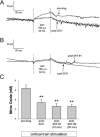Regulation of striatal nitric oxide synthesis by local dopamine and glutamate interactions
- PMID: 19799710
- PMCID: PMC2796709
- DOI: 10.1111/j.1471-4159.2009.06416.x
Regulation of striatal nitric oxide synthesis by local dopamine and glutamate interactions
Abstract
Nitric oxide (NO) is a key neuromodulator of corticostriatal synaptic transmission. We have shown previously that dopamine (DA) D1/5 receptor stimulation facilitates neuronal NO synthase (nNOS) activity in the intact striatum. To study the impact of local manipulations of D1/5 and glutamatergic NMDA receptors on striatal nNOS activity, we combined the techniques of in vivo amperometry and reverse microdialysis. Striatal NO efflux was monitored proximal to the microdialysis probe in urethane-anesthetized rats during local infusion of vehicle or drug. NO efflux elicited by systemic administration of SKF-81297 was blocked following intrastriatal infusion of: (i) the D1/5 receptor antagonist SCH-23390, (ii) the nNOS inhibitor 7-nitroindazole, (iii) the non-specific ionotropic glutamate receptor antagonist kynurenic acid, and (iv) the selective NMDA receptor antagonist 3-phosphonopropyl-piperazine-2-carboxylic acid. Glycine co-perfusion did not affect SKF-81297-induced NO efflux. Furthermore, intrastriatal infusion of SKF-81297 potentiated NO efflux evoked during electrical stimulation of the motor cortex. The facilitatory effects of cortical stimulation and SKF-81297 were both blocked by intrastriatal infusion of SCH-23390, indicating that striatal D1/5 receptor activation is necessary for the activation of nNOS by corticostriatal afferents. These studies demonstrate for the first time that reciprocal DA-glutamate interactions play a critical role in stimulating striatal nNOS activity.
Figures




Similar articles
-
Endogenous nitric oxide facilitates striatal dopamine and glutamate efflux in vivo: role of ionotropic glutamate receptor-dependent mechanisms.Neuropharmacology. 1997 Nov-Dec;36(11-12):1571-81. doi: 10.1016/s0028-3908(97)00148-2. Neuropharmacology. 1997. PMID: 9517428
-
Frontal cortical afferents facilitate striatal nitric oxide transmission in vivo via a NMDA receptor and neuronal NOS-dependent mechanism.J Neurochem. 2007 Nov;103(3):1145-56. doi: 10.1111/j.1471-4159.2007.04811.x. Epub 2007 Jul 31. J Neurochem. 2007. PMID: 17666041
-
Impact of dopamine-glutamate interactions on striatal neuronal nitric oxide synthase activity.Psychopharmacology (Berl). 2010 Jan;207(4):571-81. doi: 10.1007/s00213-009-1687-0. Epub 2009 Oct 9. Psychopharmacology (Berl). 2010. PMID: 19816675 Free PMC article.
-
Phasic dopaminergic transmission increases NO efflux in the rat dorsal striatum via a neuronal NOS and a dopamine D(1/5) receptor-dependent mechanism.Neuropsychopharmacology. 2006 Mar;31(3):493-505. doi: 10.1038/sj.npp.1300826. Neuropsychopharmacology. 2006. PMID: 16012530
-
The effect of striatal dopamine depletion on striatal and cortical glutamate: A mini-review.Prog Neuropsychopharmacol Biol Psychiatry. 2016 Feb 4;65:49-53. doi: 10.1016/j.pnpbp.2015.08.013. Epub 2015 Sep 1. Prog Neuropsychopharmacol Biol Psychiatry. 2016. PMID: 26334687 Free PMC article. Review.
Cited by
-
Distributed dopaminergic signaling in the basal ganglia and its relationship to motor disability in Parkinson's disease.Curr Opin Neurobiol. 2023 Dec;83:102798. doi: 10.1016/j.conb.2023.102798. Epub 2023 Oct 30. Curr Opin Neurobiol. 2023. PMID: 37866012 Free PMC article. Review.
-
Amperometric measurements of cocaine cue and novel context-evoked glutamate and nitric oxide release in the nucleus accumbens core.J Neurochem. 2020 Jun;153(5):599-616. doi: 10.1111/jnc.14952. Epub 2020 Feb 3. J Neurochem. 2020. PMID: 31901130 Free PMC article.
-
Learning new sequential stepping patterns requires striatal plasticity during the earliest phase of acquisition.Eur J Neurosci. 2017 Apr;45(7):901-911. doi: 10.1111/ejn.13537. Epub 2017 Feb 27. Eur J Neurosci. 2017. PMID: 28177160 Free PMC article.
-
Electrical stimulation of the hippocampal fimbria facilitates neuronal nitric oxide synthase activity in the medial shell of the rat nucleus accumbens: Modulation by dopamine D1 and D2 receptor activation.Neuropharmacology. 2017 Nov;126:151-157. doi: 10.1016/j.neuropharm.2017.09.005. Epub 2017 Sep 5. Neuropharmacology. 2017. PMID: 28887183 Free PMC article.
-
Dopamine from cirrhotic liver contributes to the impaired learning and memory ability of hippocampus in minimal hepatic encephalopathy.Hepatol Int. 2013 Jul;7(3):923-36. doi: 10.1007/s12072-013-9431-6. Epub 2013 Mar 13. Hepatol Int. 2013. PMID: 26201931
References
-
- Ainsworth K, Smith SE, Sharp T. Repeated administration of fluoxetine, desipramine and tranylcypromine increases dopamine D2-like but not D1-like receptor function in the rat. J. Psychopharmacol. 1998;12:252–257. - PubMed
-
- Araki T, Mizutani H, Matsubara M, Imai Y, Mizugaki M, Itoyama Y. Nitric oxide synthase inhibitors cause motor deficits in mice. Eur. Neuropsychopharmacol. 2001;11:125–133. - PubMed
-
- Boehning D, Snyder SH. Novel neural modulators. Annu. Rev. Neurosci. 2003;26:105–131. - PubMed
Publication types
MeSH terms
Substances
Grants and funding
LinkOut - more resources
Full Text Sources
Miscellaneous

